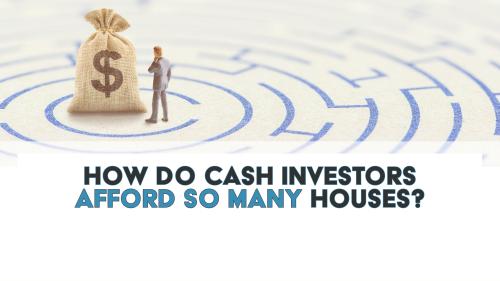
Our company opened for business in March 2019 and since then it has bought multiple apartment complexes and more than 50 houses without using a dollar of the company’s or its owner’s cash. You may be thinking that’s outlandishly far-fetched or even that the ability to buy multiple houses is possible for only the extravagantly wealthy. It’s not! The fact is that you don’t need money to buy houses, but you do need to know other people who have money to buy houses. In this article, we explain how cash home investors manage to buy dozens, or even hundreds, of houses every year by leveraging OPM, the ways investors use OPM, and we have included examples of how to buy real estate without needing your own cash.
In home investing, the acronym “OPM” means using Other People’s Money as leverage to buy real estate without using any of your own cash. Using OPM allows cash home investors to amplify returns, reduce risk, and to buy investments which exceed their personal funds. As a creative way to finance real estate purchases, investors often structure their use of OPM as private and hard money loans, equity partnering, seller financing, and even conventional bank loans.
The amount of money in the world is finite. The same goes for your own bank account, and if you spent your last dollar, you couldn’t even afford your next meal. When cash investors buy homes, the same principle prevails – if they use their own money, investors will soon run out of capital to buy more houses. But if they use Other People’s Money, the number of homes cash investors can afford is limited only to the amount of capital within their financial network. For example, assuming a cash investor has $100,000 in the bank, they can buy one $100,000 home. Now assume they instead buy the home using a private money lender. The investor now owns and controls the $100,000 home and has the cash to, for instance, buy a second $100,000 house. This is admittedly a very simple example with an equally simple use of the investor’s personal funds, however, by owning $200,000 instead of $100,000 in real estate, compare the difference in the cash investors net worth in just 10 years:
By using OPM to buy the first house, the cash investor could afford a second house and in in 10-years it made him $169,202 wealthier. Other more profitable strategies exist to park the investor’s personal cash, so we don’t recommend implementing the example above. Nonetheless, it clearly shows the power of leverage and why investors prefer to use OPM when buying homes.
Where do you get OPM and what ways can you use leverage to build wealth through owning real estate? There are several approaches and here is a list of the 5 most common ways to tap into Other People’s Money.
Private money lenders are not banks, they’re instead your friends and family and the friends of your friends and family who have surplus funds and are willing to lend them to you. This way of funding more real estate investments has 2 notable advantages. First, cash home investing businesses can buy multiple houses due to the flexible structure of private money loans which include equity and/or interest financing. With equity financing, the cash investor sells an ownership stake in the investment to the private money lender. With interest financing, the cash investor instead makes interest payments without selling an ownership stake. Second, in real estate, cash is king, and speed is queen. Cash investors can afford to purchase dozens of houses because closing private money loans are extremely quick, often closing in 1 day instead of, for example, traditional mortgages which average 45 days. Private money is also the easiest financing to get which makes it the predominant strategy investors with cash at Good Vibes Homebuyers use to buy multiple homes each year. Here’s what the typical private money financing structure looks like:
A cash home buyer could afford to purchase her next investment herself, but she would prefer to use her friends and family’s cash, so she presents the deal to her friend. The home’s purchase price is $100,000, it will require $30,000 in rehab, and after it’s rehabbed will have an After Repair Value (ARV) of $180,000. The private money lender agrees to loan her cash investor friend $130,000 at 7% interest for 1-year. The investor must then make interest-only payments of $758.33 each month. The home was rented after 3-months and at the end of 12 months, the home is refinanced into a conventional loan at 75% of its ARV which equals $135,000. As a result, the private money lender got back all her money plus $9,100 (in interest payments), and the cash investor bought the house literally without using any money of their own (rent covered the interest payments).
Leveraging Other People’s Money through hard money lenders does not mean that it’s hard to get financing. Rather, it means that these lenders concern themselves with the “hard” asset itself (i.e., the house). They ask, “how much will the home be worth once it’s all fixed up” and then underwrite the hard loan based on a percentage of the home’s ARV. This system supplies cash investors with 3 notable benefits. First, you can secure a hard money loan even if you don’t have a great credit score. Second, you can use hard money loans for outdated and dilapidated properties, making them ideal for fix & flip investors. Third, you don’t need to personally know high-net-worth individuals to obtain a hard money loan. Here’s an example of how a standard hard money loan works:
Assume that a cash investor has struck a deal to buy another home for $100,000. It will require $30,000 in renovations and it’s ARV is $180,000. The hard money lender will loan 70% of the home’s ARV, which equals $126,000. In return, the borrower must make a $4,000 down payment and pay $4,780 in points and lender fees. This totals $8,780 out-of-pocket. The hard money lender charges the cash investor 12% interest (which is average but can be as high as 20%) which means the borrower must make interest-only monthly payments of $1,260. Luckily, this deal goes as planned with the investor selling the home in 3 months for $180,000 resulting in a $23,140 profit (assumes 10% in sale fees).
Our investors have found that when you find a good deal, the money needed to close that deal will find you. This is to say that if you have the skills and time, you’ll find equity partners who will finance as many good investments as you can find, and this has 2 significant advantages. First, because you aren’t making interest payments, your cash flow is boosted. Second, your downside is limited because should the investment go poorly and you ultimately sell at a loss, you don’t owe equity partners more than their equity interest (e.g., if they invest $100,000 and you sell for $90,000, you don’t owe them the other $10,000). Here an example of how you could buy another investment house using equity partners:
An investor finds a sweet deal but doesn’t have the cash to cover the $100,000 purchase price nor the $30,000 in rehab expenses. All fixed up, the home’s estimated value is $180,000 (and it’s in a highly appreciating neighborhood that would make a great rental house). The investor calls their go-to private money lender, but they decline. Luckily, the private money lender has another friend whose been itching to invest in real estate. The investor calls the referral, and they agree to an equity partnership where the equity partner will loan $130,000 for a 50% equity stake provided the cash investor sells the home in 5 years. During their partnership, all rental profits and losses are split 50/50 and with 5-years of appreciation at 5.4% (U.S. historical average annual home appreciation rate), the cash investor sells for $234,140. After paying common selling fees, the sale nets $210,725. The equity lender who made this house investment possible then gets back their $130,000 investment plus 50% of the profit, $40,363 (or, 31% of their investment).
Cash investors can afford hundreds of houses when sellers understand the benefits of owner financing which is where the seller takes on the role of the bank but instead of giving cash to the investor, they extend credit. The buyer then makes regular installment payments to the seller over a pre-agreed timeframe. This way of using Other People’s Money (or, in this case, their equity) to afford home investments has 2 benefits. First, the cash needed to close can be significantly less, which preserves funds for future investment opportunities. Second, the terms of owner financing arrangements are not set in stone, they can instead be negotiated to make the deal a win for both seller and buyer. Common negotiation terms include the sale price, down payment, monthly payment, interest rate, and loan term in years. With seller financing arrangements, the home investor not only makes money, but the seller also profits from leveraging their equity. Here’s an example:
A homeowner wants to sell for $200,000 but the home is justifiably worth just $180,000. Nonetheless, a cash investor can afford to pay $200,000, provided the homeowner agrees to seller financing. The 2 parties negotiate and ultimately agree to a $200,000 sale price, the investor pays all closing costs, he puts down $20,000, and he pays the seller monthly principal-only payments of $1,000 for 60 months. The result is that the seller sold for $38,000 more than she could have sold any other way ($20,000 over market and $18,000 in closing costs saved). What about the cash investor who leveraged the owner’s equity to buy an extra investment home? His tenant paid the monthly payments, the property grew in value to $234,140 (assumes 5.4% appreciation), and he cashed out $55,605 when he refinanced at 75% of the home’s value in 5-years.
Most people do not think of conventional loans as using Other People’s Money. But if you own a home and it doesn’t have 100% equity, you have used Other People’s Money. This type of investor financing allows cash buyers to acquire multiple houses without needing more than 25% of a home’s sale price. This results in 2 important benefits. First, buying as many houses as possible through conventional loans means that cash investors have long-term, predictable financing in place from the onset. This frees up their time to find more quality housing investments and it makes their exit strategy clearer as they’re able to project a home’s equity position over the course of the loan. Second, because traditional loans are secured by the home itself, interest rates are typically lower, which coincidentally improves the investor’s equity position and expedites the time needed for exiting the deal profitably.
Conventional financing is quite common so this article foregoes an example, however, if you’d like to learn more about how a conventional loan can be used to afford your next real estate asset, visit this Investopedia webpage.
The bottom line is that cash investors rarely use their own money when buying houses. Actually, we would contend that the most successful investors do not use their own money. Rather, experienced cash buyers understand the value of using Other People’s Money to buy and profit from real estate. This means that you don’t need a lot of money, in fact, you don’t need any of your own money to become successful at buying multiple houses every year. If you’re interested in diving into the cash house buying world, follow and send us a message on social media or call us direct! We’d be happy to offer our expertise and answer any questions for free about how you can afford your next investment property. Alternatively, if you’re interested in selling your home to a cash investor, our experienced house buyers know how to fund your deal quickly and how to pay you top dollar. Contact us right now!
You might also like
Free closing costs. Free Local Move. Zero fees. Sell in 5 days. Sell and stay for 180 days. No equity? Still get $10,000 cash!

Picking the wrong investor can leave you scrambling & empty-handed. Learn how to spot the bad from good investors & see the top reasons to pick Good Vibes Homebuyers.

What sounds better - winning or losing? Home investors don't want you to know these 4 magic negotiation tactics because you'll kick their butt and come out a winner!

Good Vibes Homebuyers might be the perfect option for many Texas property owners needing to sell a house. Ask yourself these questions to see if our investors are right for you.